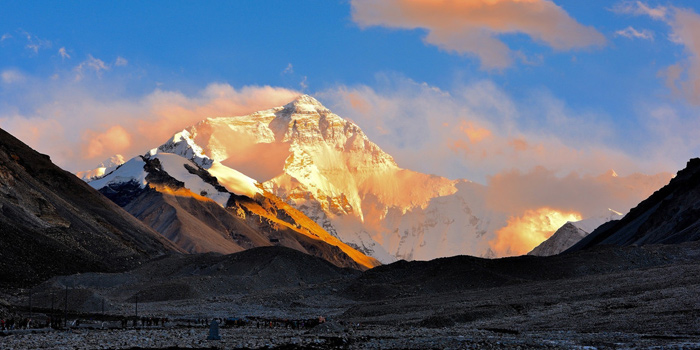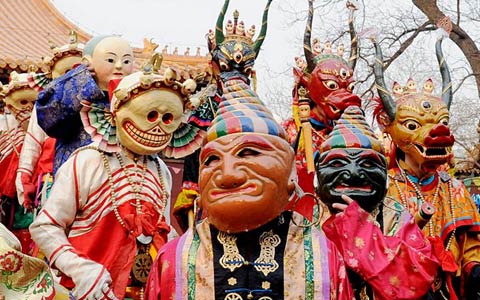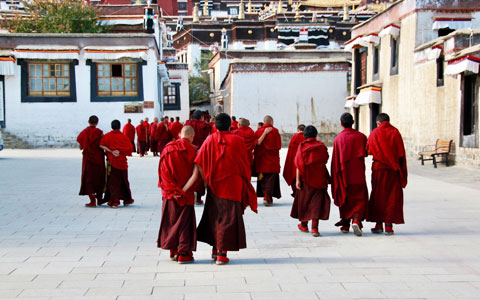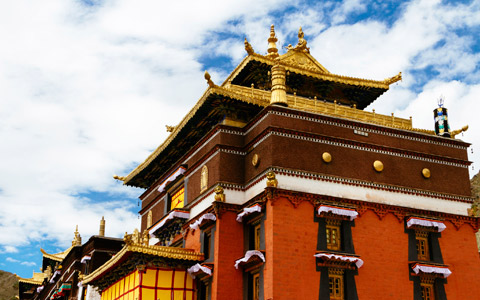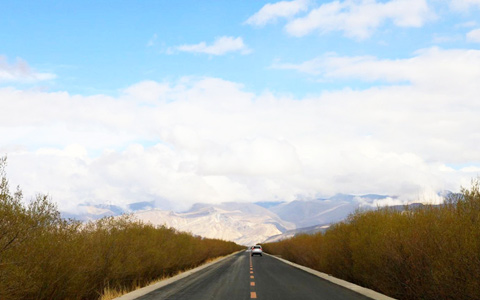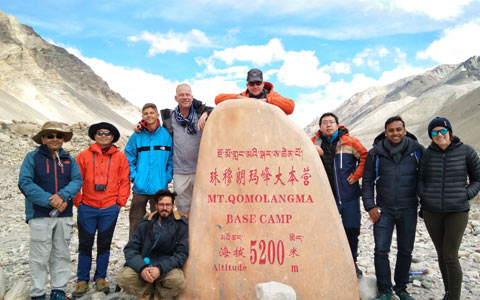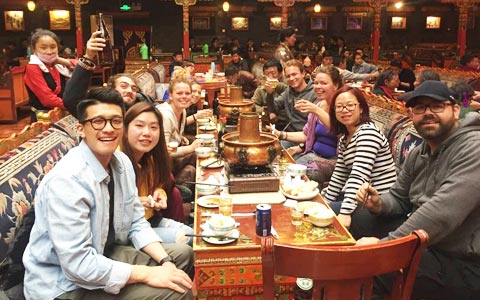Shigatse Lake: the Most Stunning Lakes in Shigatse
Shigatse, the second culture center of Tibet, owns the wonderful natural scenery and ancient holy monasteries, such as the world’s highest mountain - Mount Everest, the traditional seat of successive Panchen Lamas - Tashilhunpo Monastery, etc. Besides, lying on the plain at the confluence of the Yarlung Tsangpo and Nianchu River, Shigatse is also endowed with numerous stunning lakes, like the Yongzelutso Lake, Qudengnima Lake, Langtso Lake, Manla Reservoir, Peikutso Lake, etc. If you travel to Shigatse, you absolutely cannot miss a chance to visit these beautiful lakes.
 Yongzelutso Lake - explore the previous and present life
Yongzelutso Lake - explore the previous and present life
 Qudengnima Lake - follow the pilgrimage kora around the white gompa at the lakeshore
Qudengnima Lake - follow the pilgrimage kora around the white gompa at the lakeshore
 Langtso Lake - appreciate various colors at different time
Langtso Lake - appreciate various colors at different time
 Manla Reservoir - visit the first dam in Tibet and hang Tibetan prayer flags
Manla Reservoir - visit the first dam in Tibet and hang Tibetan prayer flags
 Xiaowutso Lake - find it through Gama Valley trekking
Xiaowutso Lake - find it through Gama Valley trekking
 Duoqing Lake - view stunning sunrise and sunset and holy Mt.Chomolhari
Duoqing Lake - view stunning sunrise and sunset and holy Mt.Chomolhari
 Peikutso Lake - enjoy the largest lake in Shigtse on the way to Kathmandu
Peikutso Lake - enjoy the largest lake in Shigtse on the way to Kathmandu
Yongzelutso Lake - explore the previous and present life
With an altitude of 5,300 meters, Yongzelutso Lake is located in “Cornucopia” - Dejilin Township, Renbu County, Shigatse. It is about 70 kilometers away from Renbu County. Yongzelutso Lake resembles a pot, with a circumference of 400 meters and an unfathomable depth. It lies at steep topography which is encircled by high mountains on three sides. The shimmering turquoise water of the lake forms a picture with the tawny surrounding mountains as if it were a jade inlaid between the mountains.
 Yongzelutso Lake is a place where you can explore you previous and present, even future life.
Yongzelutso Lake is a place where you can explore you previous and present, even future life.
It is said that this lake can show individual previous and present life. In the middle of the 7th century, Guru Rinpoche once cultivated himself in this lake. And then, it is regarded as a sacred lake by local people. The regents and other monks have gone to the lake to seek guidance on choosing the next reincarnation of Panchen Lama through visions while meditating there. Usually, the notable abbot of Tashilhunpo Monastery in Shigatse would go for a revelation to assist in the discovery of reincarnation of the Panchen Lama. Furthermore, some pilgrims come each year to Yongzelutso Lake believing that, with proper devoutness and refraining from a talk, they will be rewarded with the inspiration of their future in the sacred lake.
The best time to visit it is from April to October. During these months, the weather is not cold but warm. If you want to explore this divine lake, you can start from Renbu County, and go upstream by the river bank of Yongqu. At the same time, slowing down to enjoy the beautiful scenery of the river valley is also an excellent experience.
Just take a break to psychologically and mentally prepare yourself when you arrive at the foot of the Zelei Mountain. Because the sky ladder to the lake is still under construction, you will climb over the 5, 400 meters high mountain by walk. But you can finally catch your breath when you cross the mountain pass with an altitude of 5,300 meters. The brightly colorful prayer flags are whirring in the wind as if they are clapping for you. Below, Yongzelutso Lake lies quietly. Unfortunately, due to its special role in Tibetan Buddhism and the poor road condition, currently, Yongzelutso Lake is only open for pilgrims and Chinese travelers.
Qudengnima Lake - follow the pilgrimage kora around the white gompa at the lakeshore
A two-hour driving, about 160 kilometers, from Sangzizhu District to the south will bring you to Gamba County. The most famous Qudengnima Scenic Area is located on the slope of the Himalayan snow mountain at an altitude of 5,100 meters. Qudengnima Lake is also here. Qudengnima means “tower and sun” in the Tibetan language. According to the legend, when the tower was transported from India and passed through the mountain pass, the sun just shone on it. And then, this area was named as Qudengnima. The nearby White Gompa has also become a renowned Kora route in the local area. Pilgrims believe that they would be blessed by gods after finishing the Kora three times.
Qudengnima Lake is a small glacial lake with an altitude of 5,128 meters. About three or four miles from the Qudengnima Monastery, the clear spring water flows from the mountainside. And the water is collected into a small hole of spring. Later, this sacred lake formed. It is said that the spring water rushed out of the ground with rich minerals after ten years and seven months of circulation. According to the Tibetan Buddhist scripture, the water of Qudengnima Lake can cure 424 infectious diseases and 360 chronic diseases. It is the "nectar" that Guru Rinpoche gave his followers to heal all kind of disease. Therefore, the water of Qudengnima Lake is known as "Tibetan Shenshui"(magic water).
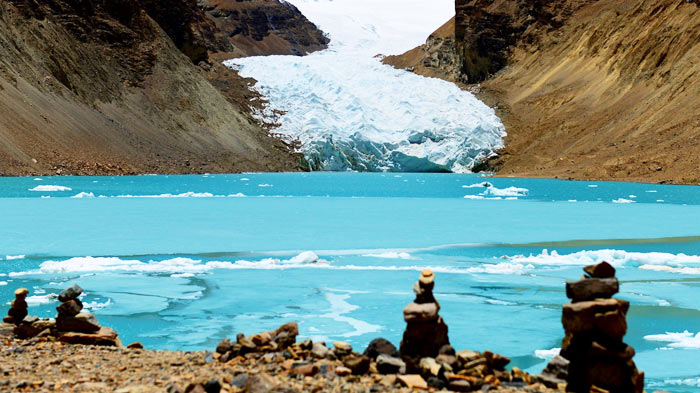 Qudengnima Lake is a small lake surrounded by three snow-capped mountains.
Qudengnima Lake is a small lake surrounded by three snow-capped mountains.
Every spring and autumn, tens of thousands of devout believers will come here to worship the Buddha, ask for “sacred water” and drink it. Many believers also bring the nectar back home and even give relatives and friends as a precious gift. Qudengnima Lake is also surrounded by three snow-capped mountains. At the end of the lake, you can see the white jade glaciers stretching into the lake. Occasionally, there are large and small ice blocks floating. The brightly colorful prayer flags are hung the lakeside, and there are many Mani stones. Behind the three snow-covered mountains, there are three small lakes, namely Yare Lake, Yu Lake, and Tong Lake. The distance between the three lakes is not so far. If time allows, you can appreciate it easily at the top of the mountain.
Langtso Lake - appreciate various colors at different time
Langtso Lake is located in the southeast of Angren County, north bank of the Yarlung Zangbo River, Shigatse, Tibet Autonomous Region. Surrounded by mountains, the lake shore is very steep. The lake is 4,300 meters above sea level and covers an area of 12.1 square kilometers. Besides, there is a small island in the lake. Unlike Qudengnima Lake, Langtso has no myths.
 It is a great thing to appreciate the various color of Langtso Lake when you travel to Shigatse.
It is a great thing to appreciate the various color of Langtso Lake when you travel to Shigatse.
But if you travel to Shigatse, you can spare some time to visit it. You can drive through National Highway 219 to get there easily. But you still have to get off and go for a walk to your destination - Langtso Lake. On the way to Langtso, you will meet an unknown river bed with several scattered horns. Perhaps they witnessed the change of this place.
When you finally get to the lake, I believe you will be amazed by the special lake. On the shore of the lake, there are piles of Nima stones. Somehow, the surface of the lake is often mixed with a variety of colors. Sometimes, it likes peacock green and blue. Later, it changes into another color. You even cannot ignore it as if you are controlled by a magic power.
Manla Reservoir - visit the first dam in Tibet and hang Tibetan prayer flags
Manla Reservoir, known as the First Dam of Tibet, is an artificial lake and situated in Longma Township, Gyangze County. If you pay a visit to it, you will be surprised by its breathtaking views and functions of irrigation, generation, water storage, and flood control.
 Our clients have payed a visit to Manla Reservoir while heading towards EBC.
Our clients have payed a visit to Manla Reservoir while heading towards EBC.
Different from the blue of Yamdrok Lake, the water of Manla Reservoir is translucent green without little flaw. It looks like warm and smooth jade, but it is softer and more gentle. The numerous prayer flags dancing with the breeze really make this a spectacular spot that will live in your memory forever.
To look the Manla Reservoir from far, it is just like a beautiful jadeite which left on the wild plateau by a fairy. You will also see the stunning white of the Kharola Glacier which covers an area of 9.4 square kilometers and has an elevation of 5,560 meters.
Xiaowutso Lake - find it through Gama Valley trekking
Xiaowutso Lake is located near the Quredang Township, Dingjie County, Tibet. It is one of the important camps to enter the world’s most beautiful valley - Gama Valley. Lying in the depth of Himalayas, Xiaowutso is an alpine lake under the Xiaowu Pass with an altitude of 4,650 meters. If you want to appreciate, you just need to take a long trek in the Gama Valley.
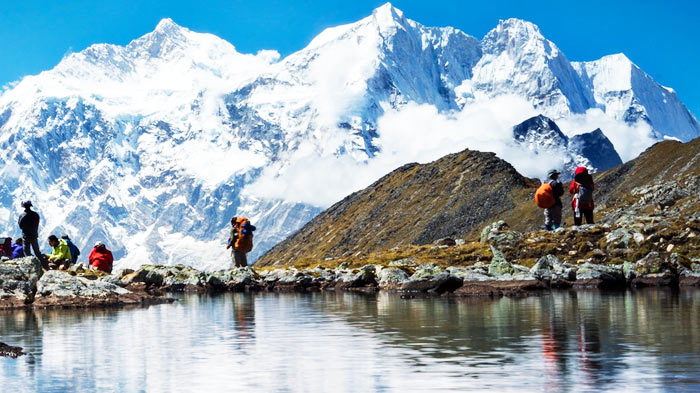 If you're planning a Gama Valley trekking,the beautiful Xiaowutso Lake is an important camping place.
If you're planning a Gama Valley trekking,the beautiful Xiaowutso Lake is an important camping place.
After arriving here, you will be fond of this quiet and small lake. The faint mist flutters gently on the surface of the lake, and some of the unknown orchids emerged from the crevices in the rock beside the lake, floating gently with the wind. Sometimes a shower of rain comes and the lake is encircled by vapor. In the embrace of the grand mountains, a clear river with white waves flows down to the valley. The clouds between the valley are blowing freely in the wind. It looks like a fairyland. To some extent, this place is a real fairyland. In addition, you can have a distant view of the Makalu (8,463m) and Chomo Lonzo (7,904m). If you are lucky, you can have the opportunity to see the Snow Mountain of Sunrise here.
Duoqing Lake - view stunning sunrise and sunset and holy Mt.Chomolhari
Located in the town of Yadong Pali, Shigatse, Duoqing lake is one of the holy lakes in Tibet. It is 4,466 meters above sea level and covers 60 square kilometers. The seventh peak of the Himalayas - Mt. Chomolhari (7,600m), known as Goddess Peak, is on the lakeside. Fifty kilometers away from Yadong County, Mt. Chomolhari is a block mountain composed by the early paleozoic strata and Himalayan granite, and formed a huge natural mountain pass.
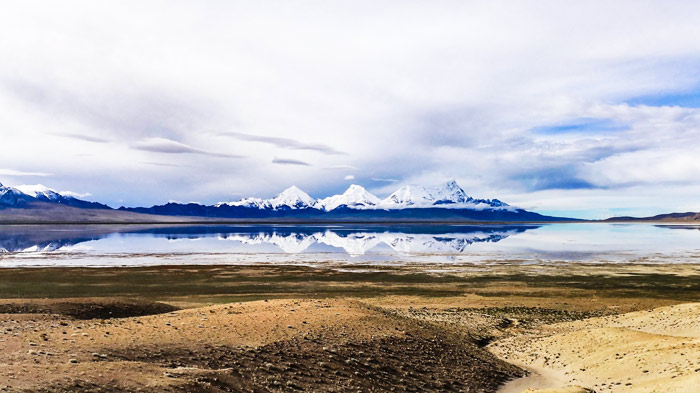 Duoqing lake is a good place for travelers to enjoy the imposing Mt. Chomolhari in Tibet.
Duoqing lake is a good place for travelers to enjoy the imposing Mt. Chomolhari in Tibet.
Here, numerous snow-capped mountains are reflected in beautiful Duoqing Lake. You will enjoy the stunning sunrise and sunset when the weather is fine. In the ancient myth of Tibet, Duoqing lake and Mt. Chomolhari are hailed as Holy Lake and Holy Mountain. When local people pass by, they will present the white Hada and barley wine to pray for the blessing of the gods.
Peikutso Lake - enjoy the largest lake in Shigtse on the way to Kathmandu
Peikutso Lake lies between Nyalam County and Gyirong County, at an elevation of 4,591 meters. It is the largest saltwater lake in Shigatse, occupying an area of 288.4 square kilometers. Surrounded by mountains from three sides, it resembles a gourd. The lake is close to the Mt. Shishapangma, the world’s 14th highest mountain. It is also a camping spot en route to western Tibet or to the new border crossing with Nepal's Langtang region.
 Peikutso Lake, as the largest lake in the Shigatse region, is a must-visit lake during your Tibet travel.
Peikutso Lake, as the largest lake in the Shigatse region, is a must-visit lake during your Tibet travel.
If you are planning to see some of the off-the-beaten-track areas of Tibet, Peikutso, undoubtedly, is a great place to go. Every year, it attracts tourists with the bright turquoise color. The drive to Peikutso Lake is also amazing that you can have an opportunity to see the excellent views of Himalayas. But you cannot drive all the way to the lake.
You will need to hike several hours after you arriving at Mount Qomolangma Nature Reserve. The hike is well worth it. Standing at the lakeside and viewing in a distance, you will be rewarded by the imposing Mt. Shishapangma towering about 60 kilometers away with snows covered around. Usually, there are also some wild animals, such as the wild horse, Tibetan antelope, Tibetan wild ass, gazelle, etc. Especially in the late autumn, birds fly and rest on the lakeside add some vitality to the lake.
Insider tips: There are no hotels and restaurants around the Peikutso Lake. If you want to camp here, please make sure you have equipped with food, sleeping bag, and tent.
What travel documents do I need for Shigatse travel?
For every international tourist who will travel to Tibet, you will need the following documents. Firstly, you have to prepare your Chinese Entry Visa. Then, you have to get your Tibet Travel Permit, which is a vital document for international travelers to enter Tibet. You are expected to apply for Tibet Travel Permit 20 days in advance so that you can board the flight or train to Tibet. However, this permit only can be obtained by a Tibetan tour operator. Hence, if you want to get your Tibet Travel Permit successfully, you have to find a reliable local travel agency, like us. Once you book your Shigatse tour with us, we will help you to get it.
Besides, Alien’s Travel Permit is also necessary for your Shigatse tour. The Alien’s travel Permit is required for all travelers heading out of Lhasa and into the opened areas of Tibet, like Shigatse. After arriving at Lhasa, our Tibetan guide will help you get it with your original Passport.
Conclusion
To sum up, apart from the holy ancient monastery, like Rongbuk Monastery, Tashilhunpo Monastery, etc., Shigatse also houses loads of stunning lakes:
Are you curious about the previous and present life? The holy Yongzelutso Lake will offer you an opportunity to get the answer.
If you want to experience the Kora route around the White Gompa at the lakeside, Qudengnima Lake would be a good place.
If you're tired of seeing a lake with simple color, you ca pay a visit to Langtso Lake and appreciate various colors of the lake at different time.
To appreciate the first dam of Tibet in Manla Reservoir and trek to Gama Valley to find the beautiful Xiaowutso Lake. If time permits, you are able to enjoy the holy Mt. Comolhari in Duoqing Lake.
Is there a unique lake in Shigatse? Peikutso Lake, definitely, is a must-see for you. Here, you can enjoy the largest saltwater lake in Shigtse and the giant Mt. Shishapangma. Wanna find more lakes here? Come join us for an indelible Shigatse Tour!

Kham Sang is responsible and honest with more than six years of guide experience in Tibet.She has strong interpersonal skills and can communicate effectively with tourists.
Related Articles & Posts
Most Popular Tibet Tour Packages
-

Lhasa - Gyantse - Shigatse - Everest Base Camp - Shigatse - Lhasa
USD939
View Details -

Lhasa - Gyantse - Shigatse - E.B.C - Saga - Kailash Trek - Darchen - Lake Manasarovar - Saga - Gyirong - Tingri - Lhasa
USD2059
View Details -

10 Days Lhasa to Everest Base Camp and Namtso Lake Small Group Tour
Lhasa - Gyantse - Shigatse - EBC - Shigatse - Lhasa - Namtso Lake - Damxung - Lhasa
USD1289
View Details -

8 Days Driving Across Himalaya Overland Adventure from Kathmandu to Lhasa
Kathmandu - Gyirong - Everest Base Camp - Tingri - Shigatse - Gyantse - Lhasa
USD1069
View Details -

4 Days Lhasa Impression Small Group Tour: Explore the Heart of Tibet and Mingle with the Locals
Lhasa
USD509
View Details -

Lhasa - Gyantse - Shigatse - Everest Base Camp - Gyirong - Kathmandu
USD979
View Details -

Lhasa - Gyantse - Shigatse- Lhasa
USD799
View Details -

13 Day Lhasa, Mt. Everest, Mt. Kailash, Lake Manasarovar and Kathmandu Adventure Tour
Lhasa - Gyantse - Shigatse - EBC - Saga - Darchen - Kailash Trek - Darchen - Saga - Gyirong - Kathmandu
USD2059
View Details


.jpg)



